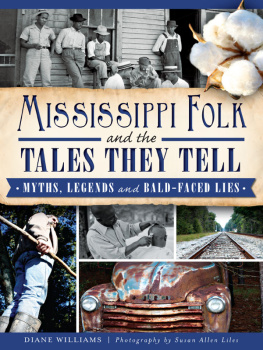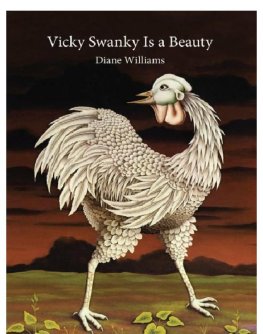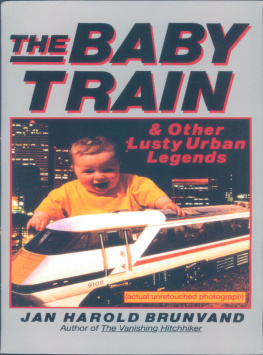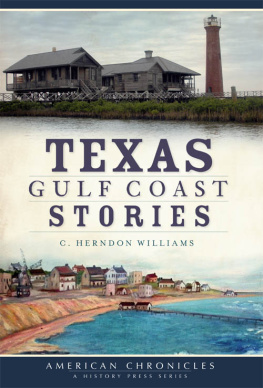
Published by The History Press
Charleston, SC 29403
www.historypress.net
Copyright 2014 by Diane Williams
Photographs by Susan Allen Liles
All rights reserved
Color cover images: Photographs by Susan Allen Liles.
All other cover images from Marion Post Wolcott, Library of Congress, Prints & Photographs Division, FSA/OWI Collection.
First published 2014
e-book edition 2014
ISBN 978.1.62584.738.6
Library of Congress Cataloging-in-Publication Data
Williams, Diane, 1953
Mississippi folk and the tales they tell : myths, legends and bald-faced lies / Diane Williams ; photographs by Susan Allen Liles.
pages cm -- (American legends)
print edition ISBN 978-1-60949-932-7 (paperback)
1. Tales--Mississippi. 2. Tall tales--Mississippi. 3. Legends--Mississippi. 4. Storytellers--Mississippi. I. Title.
GR110.M7W55 2014
398.209762--dc23
2014001907
Notice: The information in this book is true and complete to the best of our knowledge. It is offered without guarantee on the part of the author or The History Press. The author and The History Press disclaim all liability in connection with the use of this book.
All rights reserved. No part of this book may be reproduced or transmitted in any form whatsoever without prior written permission from the publisher except in the case of brief quotations embodied in critical articles and reviews.
To those who have stood by me, encouraged me, uplifted me and loved me unconditionally, you will always have a special place in my qalb. Thanks to my sister Alice Brown for all the funny jokes; Jerry L. Jenkins for being such an incredible artistic soul-friend and brother; Linda Johnson and Oni Lasana for being my encouragement; Willa Brigham for the gift of massage during the stressful times; Fellowship Bible Church for unconditional love; Susan Marquez and Benjamin Morris for being the first readers; and Nellie Mack McInnisyou are my music and melody.
CONTENTS
INTRODUCTION
Im a road hog, and Ive been traveling Mississippi listening and talking with people from all corners of the state for over twenty-five years. I started out as a transplant from New Jersey, by way of Texas, where I met my husband. When we first came home (Madison, Mississippi, his home of birth), I was very apprehensive. Of course, I had heard all the stories about my new home, especially the ones about the racial tensions and prejudices. I soon learned that I would be welcomed from the very moment I boarded the plane with a baby in my arms. The people on the plane from Houston, Texas, to Jackson, Mississippi, were very helpful in making sure that I was able to properly breastfeed my child without exposing the activity. But it could have been that they were in no mood to hear a baby cry for any length of time. Either way, I relaxed, and Im still enjoying the ride today. I feel right at home here, and even my accent can attest to that. One moment, Im talking southern, and the next minute Im being teased about my accent and everyone guesses that I must originally be from the New York area, which is true. I grew up in Newark, New Jersey, fifteen minutes outside of Manhattan, New York. I wear it as a badge of honor that says to anyone listening, Dont mess with me. I dont take no stuff. Im a mover and shaker, a workaholic, and Im still known as a city-slicker.
Because I was not familiar with the state and its culture when I first arrived, I decided to get out on the road and explorejust me and my small child. We got involved in volunteer activities and soon became acclimated. I learned that no matter what my station in life, I would always be identified not as Diane Williams but as Rays wife. I was referenced by a term of endearmenta stay-at-home wifeand the community would only respond to my identification as Rays wife. I found this to be perplexing. It seemed that I did not have an identity of my own. Ironically, I am no longer married, but I have come into my own as a professional storyteller, author and mixed media fiber artist. People now find me multifaceted, and some may go so far as to say that I am a jack-of-all-trades, to which I jokingly respond, No, its all about storytelling in a variety of formats. I am a narratologist!
I have told stories in every corner of the state and in almost every type of venue imaginableso much so that people now refer to me by saying, Oh, youre the storyteller. As I gained more experience over the years, I expanded my interests and started working with communities to help them collect their stories and value what they have to celebrate with one another. Sometimes those story gatherings have been healing balm to communities with racial tensions and identification issues. But more often than not, the stories that Ive helped communities collect have been the vehicle for helping them remember a time gone by. One of my favorite sayings is this: I help communities to uncover invisible artifacts.
I learned to collect oral histories from the University of Southern Mississippi and the Mississippi Humanities Council (MHC). I worked out in the field along with folklorists and other oral history collectors in rural communities such as New Hebron, Columbus and Prentiss, Mississippi. Those field trips helped to leave an indelible mark on communities by way of the local performances we created in celebration of the stories that were collected, the university archival storage, the creation of booklets andmy favoritethe landmark that is now positioned in concrete in front of the Okolona Carnegie Library. If you visit the site, I promise youll either ask, What is that thing on the ground? Do they worship the devil here? or youll ask someone, Whats the story behind that thing? Well, along with professional storyteller Rebecca Jernigan, the Okolona Chamber of Commerce and the architecture department at Mississippi State University, I wanted to create a labyrinth on the grounds of the public library but soon learned that there wasnt enough space around the library for this project. So thats why there is a thing on the ground. It is a metal plate embedded into the concrete. Children worked with Mississippi State Universitys architecture department to re-create the stories that were gathered and sculpt and cast the images into metal. The flat, circular metal plate depicted childlike images of home, cemeteries, people, animals, landmarks and a time gone by. Images relating to the stories that were told of the old movie theater, the swimming hole and the underground well are all finely crafted by children to the best of their abilities and ages.
It is the hope of this writer that since the storytellers came to town, there is a deeper appreciation for the invisible artifacts. People have learned from one another. Theyve heard one anothers stories, folklore and even some bald-faced liesand theyve learned to respect one another because of their stories. At first, they were afraid to share. They had kept the stories hidden in their hearts or whispered, sputtered and juked on front porches. The stories would come out, whispered around kitchen tables while women stirred pots and men slugged beer. The stories flowed and were whispered in church fellowship halls and at garden clubs, but neverneverwould the stories be told in gatherings where the entire community could learn about their history, fortitude and perseverance.
Thats the way it is in Mississippi, and thats the way it has always been. That is what has made the folktales and folklore of this state so elusive. Mississippi is surrounded with folklore, those stories that identify us by place and tradition, but trying to uncover the folktales of Mississippi has been something Ive wanted to do for many years.
Next page











